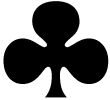A Different Sort of Count
|
|
 K 9 7 4 3 K 9 7 4 3 |
|
 K J 8 4 K J 8 4 |
|
 K 9 7 5 K 9 7 5 |
|
 ------ ------ |
|
|
 A 10 5 A 10 5 |
|
 J 8 6 2 J 8 6 2 |
|
 10 7 5 10 7 5 | |
 6 6 |
 Q 6 3 Q 6 3 | |
 J 10 8 4 J 10 8 4 |
 A 8 7 3 A 8 7 3 | |
 K 10 6 2 K 10 6 2 |
|
|
|
|  Q Q |
|
 A Q 9 3 2 A Q 9 3 2 | Contract: 6 hearts |
|
 A 2 A 2 |
|
 Q J 9 5 4 Q J 9 5 4 | Opening lead: ? |
|
This hand, I believe, is far more amenable to a count of winners than of losers. But it's a different sort of count. It's not so much that you count up to 8 in, say, 3 no, note that you need one more for your contract and might pick up an overtrick. Rather, you'd do well to count your side-suit winners and note how many trump tricks you need and ask if you can attain them.
You have no tricks coming in clubs. Oh, the cards could be sitting right for ruffing out the A K in two leads, etc., etc. But that's pie in the sky. The same holds in diamonds. You have two tricks coming. The cards could be sitting right for the the Q J 10 to fall on two leads and a ruff, but don't bet your contract on such a tenuous chance. You have one certain trick in spades and a good (odds-on) chance for a second trick on a 4-3 spade break. You also might pick up a J 10 doubleton on a 5-2 split, and that's not pie in the sky since you're not going to be banking on it but only want to notice it if they happen to fall.
This leaves us with all of four side-suit winners, meaning that in 6 hearts, we need eight heart winners. So the next step is to ask if that is feasible, and the answer can only be yes on the lead of the ace of clubs, no on a heart lead followed up by a second heart lead on getting in with the ace of spades, and I don't think so on a diamond lead. (I haven't gone through all the permutations with a diamond lead, but I believe it wipes out a key entry too early.)
So my hat is off to the defender who led hearts on the opening lead, though holding two aces against a slam contract. Declarer had no chance. However, there were declarers who got the ace of clubs opening lead, and they should have made it by a simple count of winners, and all that that count would have implied for the the play of the hand. You have to knock out the ace of spades, and now a trump lead (as one declarer got) would have left you with two trump in dummy, four in the closed hand, while you have two in the bank. If you can cash each trump separately, you've got 8 heart winners. There is the matter of entries, also, as referred to above on a diamond opening lead, but these declarers didn't get a diamond lead. Hence:
Win the heart lead in dummy. Ruff a spade, ruff a club, ruff a spade, ruff a club. When everyone followed to the third round of spades, you're contract is guaranteed, unless somebody shows up with a void in diamonds. Enter the closed hand with the ace of diamonds, cash the A Q of hearts, sluffing diamonds from dummy, and now you enter dummy with the king of diamonds, the king of spades draws the jack and a low spot wins the last trick.
Simple? Well, it's not terribly difficult once you get that favorable lead of the ace of clubs, where you're given a head start on ruffing three clubs.

Yikes! [Several years later] This is not a simple hand and I should not have implied that it's "amenable to a count of winners" as if it were on a par with most of my examples. Actually, my analysis wasn't wrongheaded (though I did have to print out the hand and check of the cards to make sure I was right). On West's third-trick trump lead, you've gotta ruff two spades in the closed hand, two more clubs in dummy then draw trump by way of a diamond entry, then get to dummy by way of another diamond to cash the top spade followed by the long spade.
A tough hand, dependent on the diamond communication, plus other favors from the defense. So my apologies to any readers who had difficulty working the hand out. But it does work on that count.

